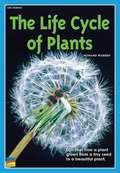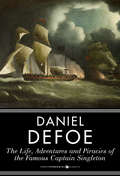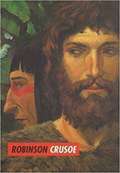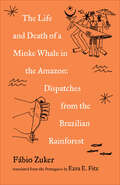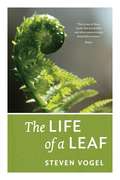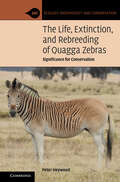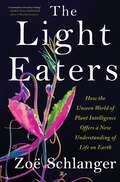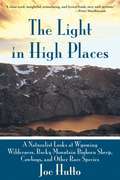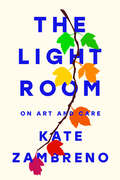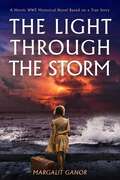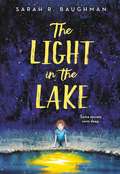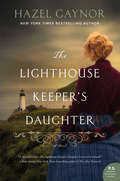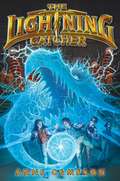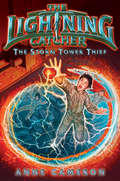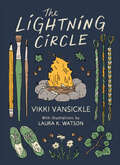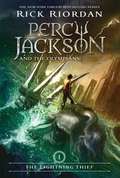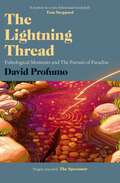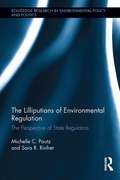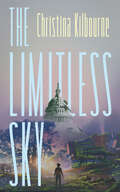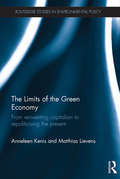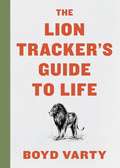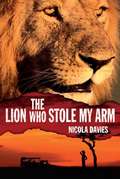- Table View
- List View
The Life Cycle of Plants
by Howard WarrenPerform this script about a girl's quest to save the buffalo from extinction.
The Life Cycles of Butterflies: From Egg to Maturity, a Visual Guide to 23 Common Garden Butterflies
by Judy Burris Wayne RichardsThis stunning photographic guide will have butterfly enthusiasts of all ages aflutter. Judy Burris and Wayne Richards include more than 400 full-color, up-close images that present the life cycles of 23 common North American butterflies in amazing detail. Watch caterpillars hatch from eggs, eat and grow, form into chrysalides, emerge as colorful butterflies, and fly through the air. You’ll also learn which plants butterflies avoid and which native species they’re attracted to, so you can create your own backyard butterfly haven.
The Life and Adventures and Piracies of the Famous Captain Singleton
by Daniel DefoeAfter being kidnapped from his family as a child, Bob Singleton is raised by the gypsy who purchased him. As a young man, he quickly takes to life at sea, and begins a series of adventures, both on and off land, eventually becoming a successful pirate known as Captain Singleton. The Life, Adventures and Piracies of the Famous Captain Singleton is written much in the same style as author Daniel Defoe’s other famous novels, including Robinson Crusoe and Journal of the Plague Year, mixing accounts of adventure with well-researched economic and practical details that ground the story in the reality of its 18th century setting. <P><P>HarperPerennial Classics brings great works of literature to life in digital format, upholding the highest standards in ebook production and celebrating reading in all its forms. Look for more titles in the HarperPerennial Classics collection to build your digital library.
The Life and Adventures of Robinson Crusoe (Core Classics)
by Michael J. Marshall Daniel DafoeCore Classics Series Stories loved for generations come to life for today's young readers in the Core Classics series. Faithful to the style, plot, and themes of the originals, Core Classics are designed for use as classroom editions of the literary works listed in the Core Knowledge Sequence. They include introductions by E. D. Hirsch Jr., editor of the Core Knowledge Series (What Your Kindergartner — Sixth Grader Needs to Know). The Core Classics are generally considered suitable for fourth and fifth grade students. The texts are illustrated, annotated, and include a brief biography of the author.<P><P> From the Introduction<P><P> The story of Robinson Crusoe was inspired by a real-life castaway. In 1705, Alexander Selkirk, a Scotsman, argued angrily with the captain of his ship over whether their boat was too leaky to sail. After the boat stopped to get fresh water at an island in the Pacific Ocean, Selkirk refused to go back on board. So the captain left him there alone with a Bible, a gun, a kettle, and a few tools and supplies. Four-and-a-half years later another English ship visiting the island saw a signal fire and found Selkirk still alive. Today, the island is named for him.
The Life and Death of a Minke Whale in the Amazon: Dispatches from the Brazilian Rainforest
by Fábio ZukerAs the Amazon burns, Fábio Zuker shares stories of resistance, self-determination, and kinship with the land. In 2007, a seven-ton minke whale was found stranded on the banks of the Tapajós River, hundreds of miles into the Amazon rainforest. For days, environmentalists, journalists, and locals followed the lost whale, hoping to guide her back to the ocean, but ultimately proved unable to save her. Ten years later, journalist Fábio Zuker travels to the state of Pará, to the town known as “the place where the whale appeared,” which developers are now eyeing for mining, timber, and soybean cultivation. In these essays, Zuker shares intimate stories of life in the rainforest and its surrounding cities during an age of raging wildfires, mass migration, populist politics, and increasing deforestation. As a group of Venezuelan migrants wait at a bus station in Manaus, looking for a place more stable than home, an elder in Alter do Chão becomes the first Indigenous person in Brazil to die from COVID-19 after years of fighting for the rights and recognition of the Borari people. The subjects Zuker interviews are often torn between ties with their ancestral territories and the push for capitalist gain; The Life and Death of a Minke Whale in the Amazon captures the friction between their worlds and the resilience of movements for autonomy, self-definition, and respect for the land that nourishes us.
The Life of a Leaf
by Steven VogelIn its essence, science is a way of looking at and thinking about the world. In The Life of a Leaf, Steven Vogel illuminates this approach, using the humble leaf as a model. Whether plant or person, every organism must contend with its immediate physical environment, a world that both limits what organisms can do and offers innumerable opportunities for evolving fascinating ways of challenging those limits. Here, Vogel explains these interactions, examining through the example of the leaf the extraordinary designs that enable life to adapt to its physical world. In Vogel's account, the leaf serves as a biological everyman, an ordinary and ubiquitous living thing that nonetheless speaks volumes about our environment as well as its own. Thus in exploring the leaf's world, Vogel simultaneously explores our own. A companion website with demonstrations and teaching tools can be found here: http://www.press.uchicago.edu/sites/vogel/index.html
The Life, Adventures, and Piracies of
by Daniel DefoeThe narrative describes the life of an Englishman, stolen from a well-to-do family as a child and raised by Gypsies who eventually makes his way to sea.One half of the book concerns Singleton's crossing of Africa and the later half concerns his life as a pirate in the Indian Ocean and Arabian Sea. Defoe's description of piracy focuses for the most part on matters of economics and logistics, making it an intriguing if not particularly gripping read. Singleton's pirate behaves more like a merchant adventurer, perhaps Defoe's comment on the mercantilism of his day.
The Life, Extinction, and Rebreeding of Quagga Zebras: Significance for Conservation (Ecology, Biodiversity and Conservation)
by Peter HeywoodQuaggas were beautiful pony-sized zebras in southern Africa that had fewer stripes on their bodies and legs, and a browner body coloration than other zebras. Indigenous people hunted quaggas, portrayed them in rock art, and told stories about them. Settlers used quaggas to pull wagons and to protect livestock against predators. Taken to Europe, they were admired, exhibited, harnessed to carriages, illustrated by famous artists and written about by scientists. Excessive hunting led to quaggas' extinction in the 1880s but DNA from museum specimens showed rebreeding was feasible and now zebras resembling quaggas live in their former habitats. This rebreeding is compared with other de-extinction and rewilding ventures and its appropriateness discussed against the backdrop of conservation challenges—including those facing other zebras. In an Anthropocene of species extinction, climate change and habitat loss which organisms and habitats should be saved, and should attempts be made to restore extinct species?
The Light Eaters: How the Unseen World of Plant Intelligence Offers a New Understanding of Life on Earth
by Zoë SchlangerNEW YORK TIMES BESTSELLER The New Yorker’s Best Books of 2024 • TIME’s 10 Best Nonfiction Books of 2024 • New York Magazine’s 10 Best Books of the Year • Washington Post’s 50 Notable Works of Nonfiction of 2024 • Smithsonian’s 10 Best Science Books of the Year • A Best Book of the Year: Boston Globe, Scientific American, New York Public Library, Christian Science Monitor, Library Journal, and Publishers Weekly • An Amazon Best Nonfiction Book of the YearLonglisted for the National Book Critics Circle Nonfiction Prize • Finalist for the Los Angeles Times Book Prize • Winner of the National Outdoor Book Award for Natural History“A masterpiece of science writing.” –Robin Wall Kimmerer, author of Braiding Sweetgrass“Mesmerizing, world-expanding, and achingly beautiful.” –Ed Yong, author of An Immense World“Rich, vital, and full of surprises. Read it!” –Elizabeth Kolbert, author of Under a White Sky and The Sixth Extinction Award-winning Atlantic staff writer Zoë Schlanger delivers a groundbreaking work of popular science that probes the hidden world of the plant kingdom, “destabilizing not just how we see the green things of the world but also our place in the hierarchy of beings, and maybe the notion of that hierarchy itself.” (The New Yorker)It takes tremendous biological creativity to be a plant. To survive and thrive while rooted in a single spot, plants have adapted ingenious methods of survival. In recent years, scientists have learned about their ability to communicate, recognize their kin and behave socially, hear sounds, morph their bodies to blend into their surroundings, store useful memories that inform their life cycle, and trick animals into behaving to their benefit, to name just a few remarkable talents.The Light Eaters is a deep immersion into the drama of green life and the complexity of this wild and awe-inspiring world that challenges our very understanding of agency, consciousness, and intelligence. In looking closely, we see that plants, rather than imitate human intelligence, have perhaps formed a parallel system. What is intelligent life if not a vine that grows leaves to blend into the shrub on which it climbs, a flower that shapes its bloom to fit exactly the beak of its pollinator, a pea seedling that can hear water flowing and make its way toward it? Zoë Schlanger takes us across the globe, digging into her own memories and into the soil with the scientists who have spent their waking days studying these amazing entities up close.What can we learn about life on Earth from the living things that thrive, adapt, consume, and accommodate simultaneously? More important, what do we owe these life forms once we come to understand their rich and varied abilities? Examining the latest epiphanies in botanical research, Schlanger spotlights the intellectual struggles among the researchers conceiving a wholly new view of their subject, offering a glimpse of a field in turmoil as plant scientists debate the tenets of ongoing discoveries and how they influence our understanding of what a plant is.We need plants to survive. But what do they need us for—if at all? An eye-opening and informative look at the ecosystem we live in, this book challenges us to rethink the role of plants—and our own place—in the natural world.
The Light In High Places: A Naturalist Looks at Wyoming Wilderness--Rocky Mountain Bighorn Sheep, Cowboys, and Other Rare Species
by Joe HuttoNaturalist Joe Hutto's latest adventures in wildlife observation take him to Wyoming's Wind River Mountains. Hutto is living in a tent at 12,000 feet, where blizzards occur in July and where human wants become irrelevant and human needs can become a matter of life and death-to study the Rocky Mountain bighorn sheep. The population of these rare alpine sheep is in decline. The lambs are dying in unprecedented numbers. Hutto's job is to find out why. For months at a time, he follows the bighorn herds, meets mountain lions and bears, weathers injury and storms, and beautifully observes the incredible splendor of the Rocky Mountains. Hutto has a deep connection to Wyoming, having managed a large cattle ranch in his past. He weaves Wyoming's history of the cowboy, mountain ecology, and the lives of the bighorn sheep into a beautiful flowing narrative. Ultimately, he discovers that the lambs are dying of a form of nutritional muscular dystrophy due to selenium deficiency, which is caused by acid rain-a grim ecological disaster caused by human pollution. Here is a new twist on a cautionary tale, and a new voice, eloquently ex-pressing the urgency that we mend our ways.
The Light Room
by Kate Zambreno&“Kate Zambreno has invented a new form. It is a kind of absolute present, real life captured in closeup.&“ —Annie Ernaux, winner of the Nobel Prize in Literature From &“one of our most formally ambitious writers&” (Esquire), a moving account of caretaking in a time of uncertainty and lossIn The Light Room, Zambreno offers her most profound and affecting work yet: a candid chronicle of life as a mother of two young daughters in a moment of profound uncertainty about public health, climate change, and the future we can expect for our children. Moving through the seasons, returning often to parks and green spaces, Zambreno captures the isolation and exhaustion of being home with a baby and a small child, but also small and transcendent moments of beauty and joy. Inspired by writers and artists ranging from Natalia Ginzburg to Joseph Cornell, Yūko Tsushima to Bernadette Mayer, Etel Adnan to David Wojnarowicz, The Light Room represents an impassioned appreciation of community and the commons, and an ecstatic engagement with the living world.How will our memories, and our children&’s, be affected by this time of profound disconnection? What does it mean to bring new life, and new work, into this moment of precarity and crisis? In The Light Room, Kate Zambreno offers a vision of how to live in ways that move away from disenchantment, and toward light and possibility.
The Light Through the Storm: A Heroic WW2 Historical Novel Based on a True Story
by Margalit GanorA perilous journey through the unthinkable. A riveting story of hope and survival. Can their faith shield them against unbridled hatred?August, 1942. When they realize the danger of remaining under the rule of the Nazi occupation, Dr. Leon Schmelzer, his wife Donya, and their baby daughter attempt to flee Romania under the cover of darkness. Joining a dozen other brave souls, they hastily board a small ship, leaving behind family, friends, and the only life they ever knew—for a slim chance at survival.But their path to freedom does not sail over smooth waters. As endless waves threaten to drown what little hope they have, the desperate refugees find that the hatred in the hearts of men is more terrifying than any force of nature. And when they are shipwrecked and taken captive in a foreign land, Leon&’s own faith and resolve are put to the ultimate test. Can he find the courage and resourcefulness to protect his wife and only daughter?
The Light in High Places
by Joe HuttoHutto is living in a tent at twelve thousand feet, where blizzards occur in July and where human wants become irrelevant and human needs can become a matter of life and death-to study the Rocky Mountain bighorn sheep. The population of these rare alpine sheep is in decline. The lambs are dying in unprecedented numbers. Hutto's job is to find out why.For months at a time, he follows the bighorn herds, meets mountain lions and bears, weathers injury and storms, and beautifully observes the incredible splendor of the Rocky Mountains.Hutto has a deep connection to Wyoming, having managed a large cattle ranch in his past. He weaves Wyoming's history of the cowboy, mountain ecology, and the lives of the bighorn sheep into a beautiful flowing narrative. Ultimately, he discovers that the lambs are dying of cystic fibrosis due to selenium deficiency, which is caused by acid rain-a grim ecological disaster caused by human pollution. Here is a new twist on a cautionary tale, and a new voice, eloquently expressing the urgency that we mend our ways.
The Light in the Lake
by Sarah BaughmanA remarkable debut novel that takes readers on a journey of discovery, magic, science, and hope. <P><P>Twelve-year-old Addie should stay away from Maple Lake. After all, her twin brother, Amos, drowned there only a few months ago. But its crisp, clear water runs in Addie's veins, and the notebook Amos left behind -- filled with clues about a mysterious creature that lives in the lake's inky-blue depths -- keeps calling her back. <P><P>So despite her parents' fears, Addie accepts a Young Scientist position studying the lake for the summer, promising she'll stick to her job of measuring water pollution levels under adult supervision. <P><P>Still, Addie can't resist the secrets of Maple Lake. She enlists the lead researcher's son, Tai, to help her investigate Amos's clues. As they collect evidence, they also learn that Maple Lake is in trouble -- and the source of the pollution might be close to home. <P><P>Addie finds herself caught between the science she has always prized and the magic that brings her closer to her brother, and the choice she makes will change everything.
The Lighthouse Keeper's Daughter: A Novel
by Hazel GaynorFrom The New York Times bestselling author of The Girl Who Came Home comes a historical novel inspired by true events, and the extraordinary female lighthouse keepers of the past two hundred years.“They call me a heroine, but I am not deserving of such accolades. I am just an ordinary young woman who did her duty.”1838: Northumberland, England. Longstone Lighthouse on the Farne Islands has been Grace Darling’s home for all of her twenty-two years. When she and her father rescue shipwreck survivors in a furious storm, Grace becomes celebrated throughout England, the subject of poems, ballads, and plays. But far more precious than her unsought fame is the friendship that develops between Grace and a visiting artist. Just as George Emmerson captures Grace with his brushes, she in turn captures his heart.1938: Newport, Rhode Island. Nineteen-years-old and pregnant, Matilda Emmerson has been sent away from Ireland in disgrace. She is to stay with Harriet, a reclusive relative and assistant lighthouse keeper, until her baby is born. A discarded, half-finished portrait opens a window into Matilda’s family history. As a deadly hurricane approaches, two women, living a century apart, will be linked forever by their instinctive acts of courage and love.
The Lightning Catcher
by Anne CameronWelcome to the Perilous Exploratorium for Violent Weather and Vicious Storms. Be prepared for: 1. Extreme weather2. Extreme action3. Extreme laughter4. Extreme friendship5. extreme dangerProceed at your own risk.
The Lightning Catcher: The Storm Tower Thief
by Anne CameronThe funny, fast-paced second book in The Lightning Catcher series! Science, weather, and the fantastical combine for a school adventure story, part Storm Chasers and part Percy Jackson, about twelve-year-old Angus and his dangerous gift of predicting catastrophic weather.Angus has a lot on his plate. He's attending the Perilous Exploratorium for Violent Weather and Vicious Storms, learning how to battle all sorts of extreme weather. He's a Storm Prophet--one of the rare people with the ability to predict catastrophic weather. His parents--world renowned Lightning Catchers themselves--have been kidnapped. And now Perilous has been slammed by a ferocious winter storm, artifacts from the Great Fire of 1666 have been stolen, and the evil Scabious Dankheart has released deadly spores called Ice Diamonds to plague the population. Angus and his friends must find the legendary Lightning Heart--a bloodred, heart-shaped stone of great power--in order to put everything right. Action-packed, lighthearted, and perfect for reluctant readers!
The Lightning Circle
by Vikki VanSickleAn intimate coming-of age novel for teens, told in verse with delicate line art, chronicling the beauty, magic and transformative power of summer camp, for fans of Elizabeth Acevedo and Judy Blume.After having her heart broken, seventeen-year-old Nora Nichols decides to escape her hometown and take a summer job as an arts and crafts counsellor at an all-girls' camp in the mountains of West Virginia. There, she meets girls and women from all walks of life with their own heartaches and triumphs. Immersed in this new camp experience, trying to form bonds with her fellow counselors while learning to be a trusted adviser for her campers, Nora distracts herself from her feelings, even during the intimate conversations around the nightly campfires. But when a letter from home comes bearing unexpected news, Nora finds inner strength in her devastation with the healing power of female friendship. Presented as Nora's camp journal, including Nora's sketches of camp life, scraps of letters, and spare poems, The Lightning Circle is an intimate coming-of-age portrait.
The Lightning Thief (Percy Jackson and the Olympians #1)
by Rick RiordanPercy Jackson about to be kicked out of boarding school... again. And that's the least of his troubles. Lately, mythological monsters and the gods of Mount Olympus seem to be walking straight out of the pages of Percy's Greek mythology textbook and into his life. And worse, he's angered a few of them. Zeus's master lightning bolt has been stolen, and Percy is the prime suspect. Now Percy and his friends have just ten days to find and return Zeus's stolen property and bring peace to a warring Mount Olympus. But to succeed on his quest, Percy will have to do more than catch the true thief: he must come to terms with the father who abandoned him; solve the riddle of the Oracle, which warns him of betrayal by a friend; and unravel a treachery more powerful than the gods themselves. <P><P> Winner of Pacific Northwest Library Association’s Young Reader’s Choice Intermediate Award
The Lightning Thread: Fishological Moments and The Pursuit of Paradise
by David ProfumoFrom award winning novelist and journalist David Profumo comes a dazzling work about the restorative power of nature and finding joy in simple pleasures. The Lightning Thread takes the reader on a journey of unexpected delight, personal pleasure and profound discovery. From angling with his father on a spating burn at the height of the Profumo Affair to knocking back mojitos while hunting for Permit, &‘the Robocop of the sea&’, off the coast of Cuba. Much more than just another book about fishing, The Lightning Thread is an exploration of joy and a celebration of simple pleasures in a too complicated world. The significance of angling, as David writes about it, far transcends the mere catching of fish. It is about the extraordinary places he has visited, the remarkable people he has met and the great happiness pursuing his life&’s passion has brought him. Written with warmth, wit and lightly worn erudition, his references range from Ted Hughes to Wittgenstein, from W.C. Fields to Milton, and always hovering in the background is the spectre of Isaak Walton&’s TheCompleat Angler, the Ur-text of halieutic literature. A work of the passionate eclecticism, deep intelligence and virtuosically exuberant prose from one of our finest writers, The Lightning Thread is a future classic and the culmination of lifetime's obsession.
The Lilliputians of Environmental Regulation: The Perspective of State Regulators (Routledge Research in Environmental Policy and Politics)
by Michelle C. Pautz Sara RinfretWhen we think about environmental policy and regulation in the U.S., our attention invariably falls on the federal level and, more specifically, the U.S. Environmental Protection Agency. Although such a focus is understandable, it neglects the actors most responsible for the implementation and maintenance of the nation's environmental laws - the states. Recognition of the importance of the states still ignores an even smaller subsection of actors, inspectors. These front-line actors in state environmental agencies are the individuals responsible for writing environmental rules and ensuring compliance with those rules. They play an important role in the environmental regulatory state. With data collected from more than 1,200 inspectors across 17 states, Michelle C. Pautz and Sara R. Rinfret take a closer look at these neglected actors to better understand how environmental regulators perceive the regulated community and how they characterize their interactions with them. In doing so, they explore the role these front-line actors play, what it is like to be them, what they think of their place in the environmental regulatory system, and how they interact with the regulated community. An original, timely and unmatched volume advancing the debate on the future of environmental regulation in the U.S.
The Limitless Sky
by Christina KilbourneRook and Gage live worlds apart — but somehow they must find a way to help one another survive.Trapped in a life she didn’t choose, Rook struggles to find meaning in her appointed role as an apprentice Keeper of ArHK. Even though her mam soothes her with legends of the Outside and her da assures her there are many interesting facts to discover in the Archives, Rook sees only endless years of tracking useless information. Then one day Rook discovers historic footage of the Chosen Ones arriving in ArHK, and she begins to realize her mam’s legends are more than bedtime stories. That’s when Rook begins her perilous and heartbreaking search for the limitless sky.Gage is also trapped. Living on the frontier line with his family, his is a life of endless moving and constant danger. As he works with the other scouts, Gage searches for the Ship of Knowledge to help his society regain the wonders of the long distant past, when machines transported people across the land, illnesses could be cured, and human structures rose high into the sky.Will Rook and Gage escape the traps and perils that await them in order to save each other’s worlds? If they don’t, it could very well mean the end of humanity.
The Limits of the Green Economy: From re-inventing capitalism to re-politicising the present (Routledge Studies in Environmental Policy)
by Anneleen Kenis Matthias LievensProjecting win-win situations, new economic opportunities, green growth and innovative partnerships, the green economy discourse has quickly gained centre stage in international environmental governance and policymaking. Its underlying message is attractive and optimistic: if the market can become the tool for tackling climate change and other major ecological crises, the fight against these crises can also be the royal road to solving the problems of the market. But how ‘green’ is the green economy? And how social or democratic can it be? This book examines how the emergence of this new discourse has fundamentally modified the terms of the environmental debate. Interpreting the rise of green economy discourse as an attempt to re-invent capitalism, it unravels the different dimensions of the green economy and its limits: from pricing carbon to emissions trading, from sustainable consumption to technological innovation. The book uses the innovative concept of post-politics to provide a critical perspective on the way green economy discourse represents nature and society (and their interaction) and forecloses the imagination of alternative socio-ecological possibilities. As a way of repoliticising the debate, the book advocates the construction of new political faultlines based on the demands for climate justice and democratic commons. This book will be of interest to students and scholars of environmental politics, political ecology, human geography, human ecology, political theory, philosophy and political economy. Includes a foreword written by Erik Swyngedouw (Professor of Geography, Manchester University).
The Lion Tracker's Guide to Life
by Boyd VartySomewhere deep inside, you know what your gift, purpose, and mission are. Boyd Varty, a lion tracker and life coach, reveals how the wisdom from the ancient art of tracking can teach you how to recognize these essential ingredients in a meaningful life. Know how to navigate, don’t worry about the destination, and stay alert. These are just a few of the strategies that contribute to both successful lion tracking and a life of fulfillment. When we join Boyd Varty and his two friends tracking lions, we are immersed in the South African bush, and, although we learn some of the skills required for actual tracking, the takeaways are the strategies that can be applied to our everyday lives. Trackers learn how to use all of their senses to read the environment and enter into a state of “greater aliveness.” When we learn to find and follow our inner tracks, we learn to see what is deeply important to us. In the same way the trip in the classic Zen and the Art of Motorcycle Maintenance was a vehicle to examine how to live out our values, the story of this one-day adventure—with danger and suspense along the way—uses the ancient art of tracking to convey profound lessons on how to live a purposeful, meaningful life of greater harmony.
The Lion Who Stole My Arm (Heroes of the Wild)
by Nicola DaviesZoologist Nicola Davies presents an illustrated novel for young readers that proves you don’t need two arms to be strong. Pedru has always wanted to be a great hunter like his father, but after a lion takes his arm, he worries that he’ll always be the crippled boy instead. Pedru longs to kill the lion that mauled him and strengthens himself to be ready for the hunt. But when the opportunity arises, will Pedru have the strength to turn his back on revenge? Zoologist Nicola Davies perfectly merges a heart-pounding adventure with an important message about conservation, and Annabel Wright’s gorgeous black-and-white illustrations bring Pedru’s story to life.
